
It’s extremely necessary to know what steps to take if you come across a mountain lion on the trail. Read on to learn how to respond to a mountain lion encounter while hiking with your kids, and how to have this proactive conversation without scaring them.
Before, we get into this post about responding to a mountain lion on the trail, I’d like to introduce myself.
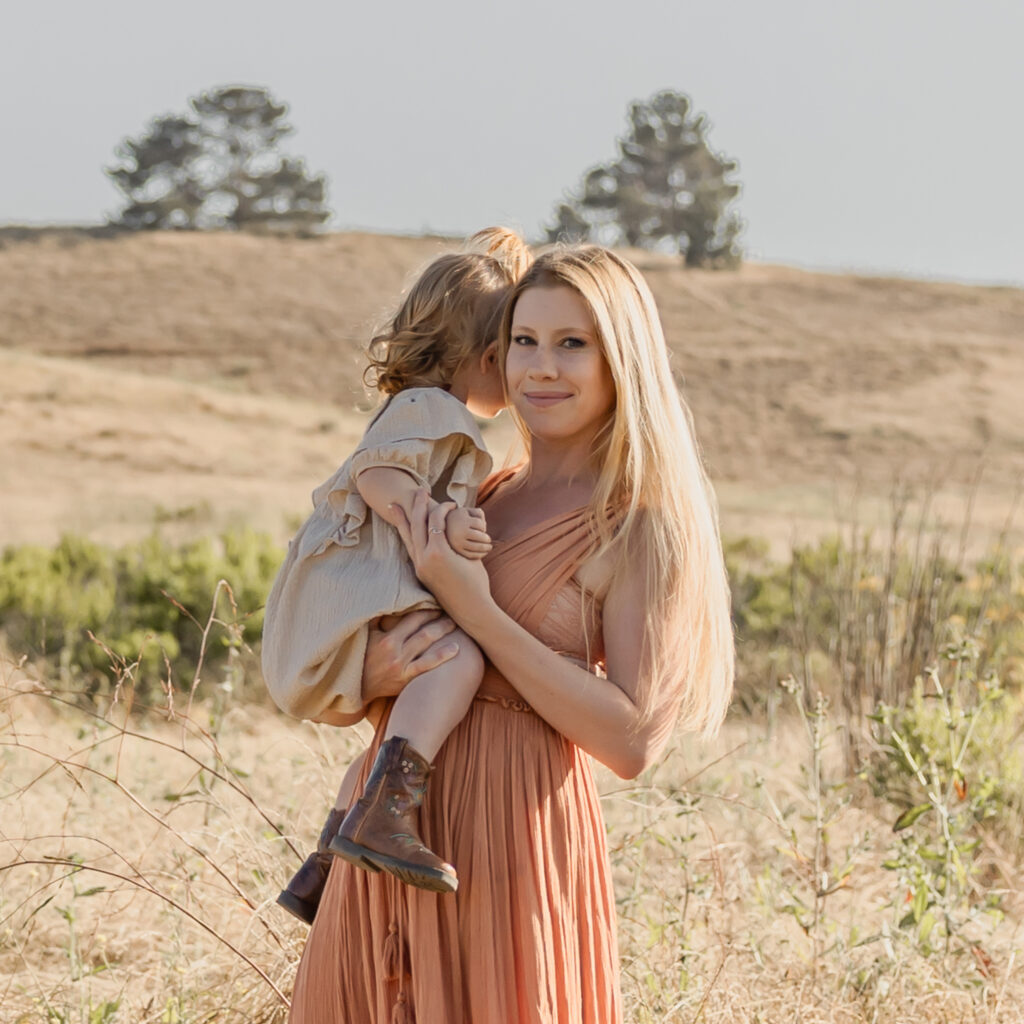
Hi! I’m Kaleigh. I am a mom of two young daughters that I adventure with very frequently. I write about wilderness safety and preparedness, and I routinely teach it to my daughters in an effort to raise very aware and prepared outdoor enthusiasts. It is extremely important to me that I am passing along the most factual and helpful information. I spend a very large amount of time researching my subjects and gaining my own personal experience so I can teach from a place of both book and street smarts.
This blog post is a combination of my research from credible sources (listed below) that I have tailored to mothers hiking with their children, as well as a personal account of encountering a mountain lion on the trail from my own dad.
I hope you find this information helpful and empowering.
Let’s get into it…
My daughters and I were hiking one of our usual trails when we were told by a passing hiker that there was a pack of coyotes on an adjoining trail (a decent distance from our current location) that were stalking a deer.
We talked through our situation and decided to continue hiking. For a number of reasons, I felt safe doing so.
This situation led us to a conversation about wildlife safety while hiking, and the cascade of enthusiastic kid questions began.
Quickly, we were talking about what would happen if we encountered a mountain lion…
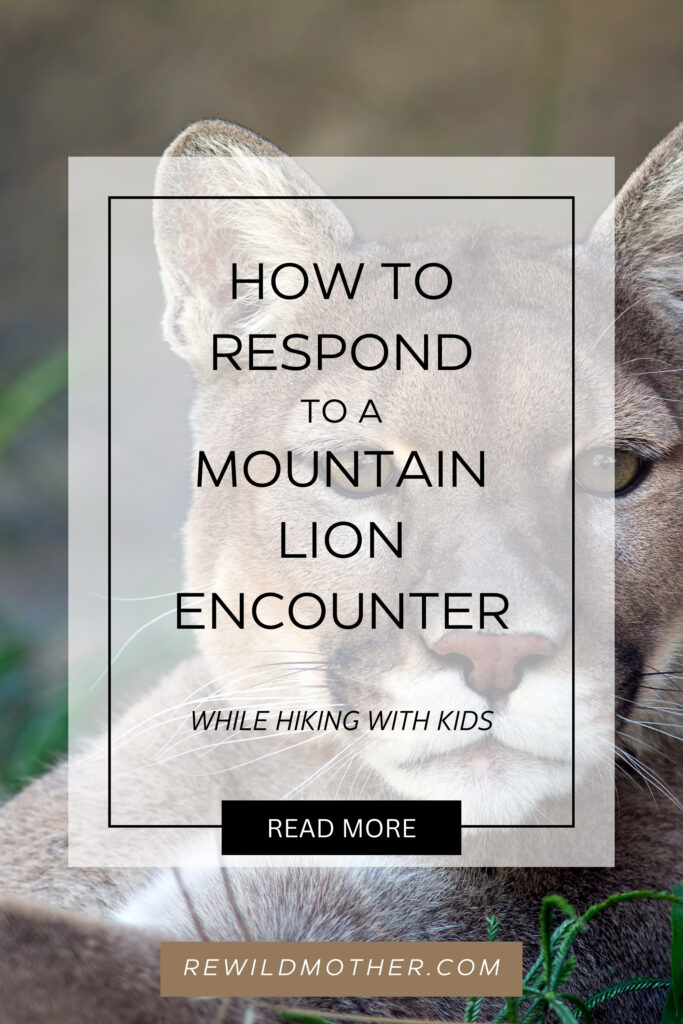
Here’s the exact conversation that I had with my 7-year-old after she became nervous about the possibility of seeing a mountain lion on the trail we were on:
I explained, “Mountain lions are very smart. They know that they have to stay the strongest and healthiest they can be so they can hunt for food for themselves and their babies. They aren’t going to risk injury or infection if they don’t have to.
If we saw a mountain lion on the trail this is what I’d do:
First, I’d make sure you were safely behind me without turning our backs to the lion.
Then, I’d read its body language. I’ll decide if we should create distance calmly and let it pass or if we should stand our ground to scare it off.
If needed, I’d make myself look like the biggest and scariest predator that I could be. I’d do this by extending my arms, opening my jacket, holding my backpack up, and looking big and confusing. I’d yell in a deep voice for it to go away.”
*we took a few seconds to laugh at the mental picture of this*
I told her that I routinely review what to do during a mountain lion encounter so that it’s fresh in my mind and I can respond properly (even during a time of high adrenaline and fear).
HERE ARE THE DETAILS ABOUT HOW TO RESPOND TO A MOUNTAIN LION:
DO NOT RUN.
Don’t turn your back away from the mountain lion. Running could trigger them to think you are weak prey. They WILL outrun a person.
READ ITS BODY LANGUAGE.
Decide if you should calmly create distance between it and yourself or if you should stand your ground.
Mountain Lion behavior clues:
If the mountain lion is calmly walking or jogging, noticing you but not appearing to care, chasing after wildlife prey = RESPOND BY slowly creating distance by backing up while facing the animal and maintaining eye contact.
If the mountain lion is crouching, hissing, showing teeth, tail twitching, pouncing = RESPOND BY standing your ground, scaring it off, throwing objects, fighting back.
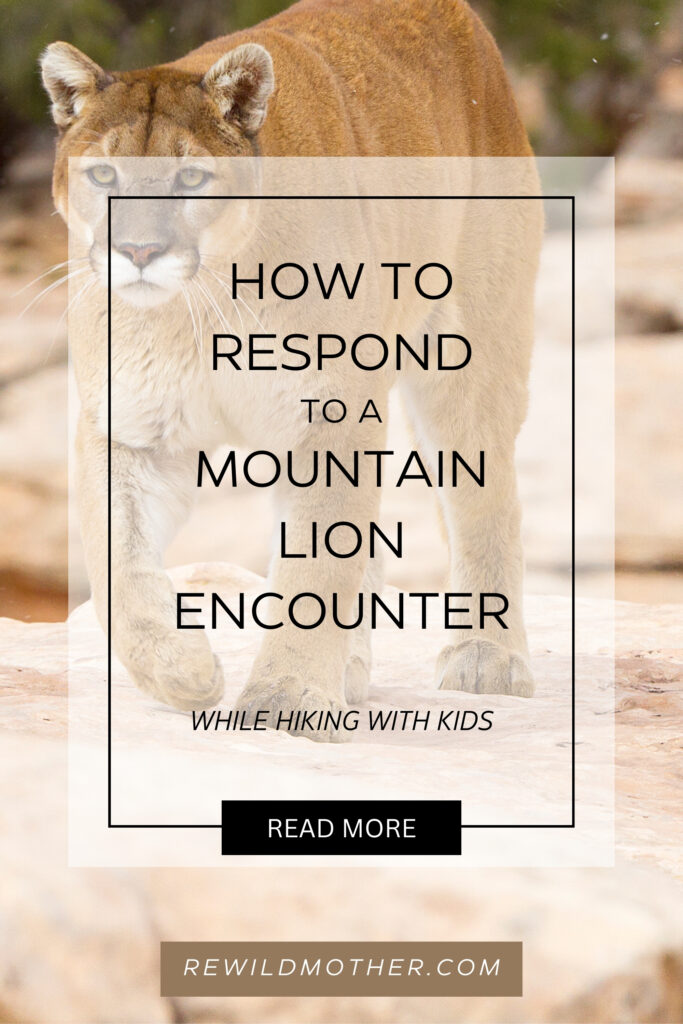
MAINTAIN EYE CONTACT.
Slowly walk backwards to put space between you and the mountain lion. Make sure the lion has an easy escape route. Take slow and steady steps so you don’t trip. If you have a child, make sure to walk as a connected pair. They can be your spotter for rocks, trail turns, or items that could cause tripping. Older children should stay close behind the adult and younger children/toddlers should be picked up so they don’t run.
MAKE YOURSELF LOOK AS LARGE AS POSSIBLE, if you need to stand your ground.
Extend arms, hold jacket and/or backpack overhead (this also sets you up to have a quick projectile, if it comes to that. DO NOT bend down to grab rocks or something to throw. Use whatever you have on your body.)
KEEP PROTECTION ITEMS IN QUICK-GRAB PLACES.
If you hike with bear spray, a pocket knife, etc, make sure they are located in a place that you can grab quickly without fumbling through your pack, bending down, etc. Side pockets and waist belts are perfect for these items.
YELL IN A DEEP VOICE.
Avoid whining, high pitched, squealing noise that the mountain lion could relate to prey animals.
I would say, “MOUNTAIN LION GO AWAY” repeatedly. It is easy to remember, quick to say, and if there is anyone else in the area that can hear us, they immediately know what the situation is.
If the mountain lion does approach, continue slowly walking backwards. If you choose to throw objects, make sure you don’t bend down to grab them, and try not to actually hit the mountain lion’s face (this could trigger a defensive response and make it think it needs to fight for its life).
This next part should be extremely rare, but it has happened before.
If a mountain lion does begin to attack, fight for your life. Bear spray can be used as a deterrent while it is approaching aggressively (watch videos about how to properly use it). If the lion is within arms reach, keep your arms in front of you to protect your neck. I also keep a pocket knife in the waist belt of my backpack ready to grab instantly, and I wouldn’t hesitate to use it if I was being attacked. Go for the most sensitive spots: eyes, nose, ears, neck.
Continue reading further below for a section about teaching your kids to stay with you if you ever encountered a mountain lion together.
My dad encountered a mountain lion while mountain biking and here’s what happened:
He was riding our usual trails in the state park that borders our neighborhood that he had ridden over 450 times prior (as documented on Strava). To his right, an adult mountain lion jumped, in a non-threatening demeanor, out of the chaparral bushes that bordered the trail. It all happened so fast. By the time that my dad was aware of the mountain lion, it had run from the chaparral, onto the trail, and was trotting at pace with him right in front of his bike. In an effort to not alert the mountain lion, my dad continued riding as normal while VERY slowly braking to try to put space between them. He carefully decided not to slam on the brakes or hop off his bike in a panic, because doing so could trigger the mountain lion to act defensively. He rode like this, down and up, through two creek bed crossings that the trail intersected with. After traveling together for approximately one very adrenaline-inducing minute, the mountain lion turned left and ran through the chaparral, again, and up a hillside. Since the mountain lion showed absolutely no interest in him and continued on its travels unfazed, my dad decided that it was safest to continue riding and get out of there as fast as possible.
Luckily, this is a very good example of how mountain lions shouldn’t want anything to do with humans. The lion was going about its day and apparently did not feel threatened by my dad so no confrontation ensued.
The lesson that we can learn from this scenario is that staying calm and creating distance should be a safe response when crossing paths with a mountain lion who doesn’t feel the need to be defensive (due to traveling with babies, defending a recent kill, etc).
On the other hand, if the mountain lion turned to my dad and was showing signs of aggression, a good response would have been to:
- Get off the bike
- Lift it up to appear large and confusing. Hope that by doing this the mountain lion will not want to risk injury by fighting this large, strange human-monster-thing.
- If needed, use the bike as a projectile to scare off the mountain lion and create more distance
- Fight for his life using items that are ready to grab on the side pockets and waist belt of the backpack
A few weeks ago, there were multiple mountain lion sightings in our local state park that we hike or mountain bike in at least once per week. Here’s the story:
At 1:30pm on a popular hiking trail, a mountain lion was spotted and photographed standing in a tree on the side of the trail. It was calmly watching passing hikers and showed no signs of aggression at the time.
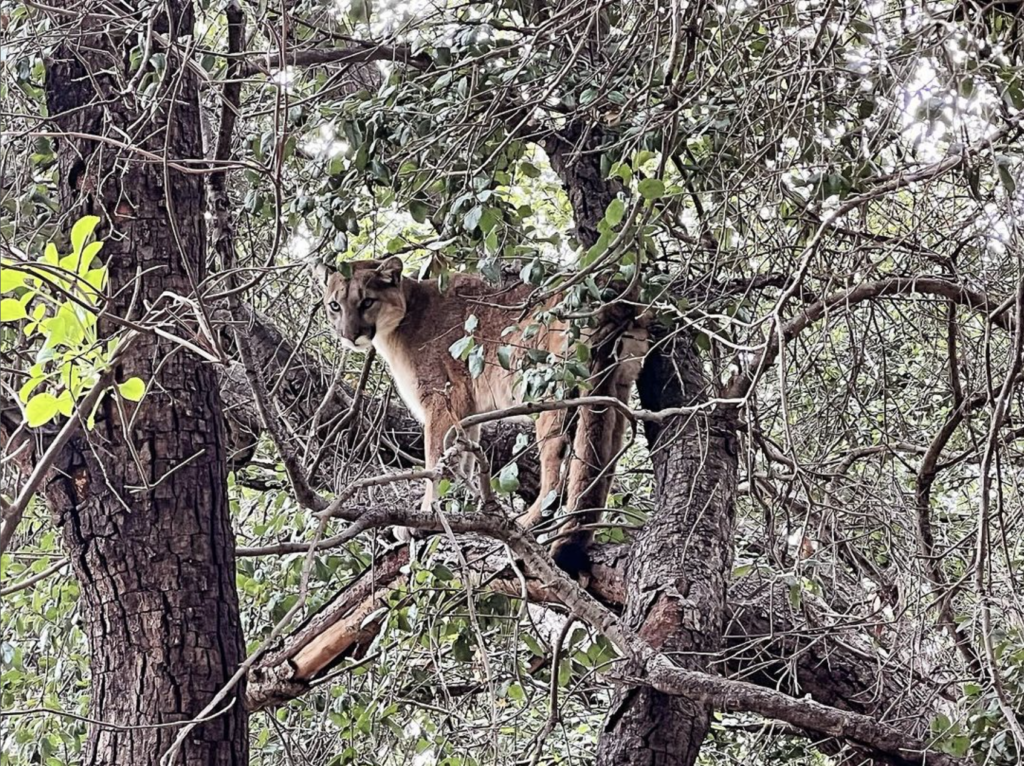
THE RESPONSE TO THIS SCENARIO:
If you were to find yourself in this scenario with your kids, here’s what to do:
- Calmly group together as single parent/child(ren) unit without turning your backs to the mountain lion. Pick up little kids without bending down (as much as possible).
- Walk backwards as a unit while keeping eye contact with the mountain lion.
- Remind kids to stay calm and together. Since the lion is currently watching in the tree, the best response is to create distance and get back to the car.
- Continue on the trail (walking backwards, maintaining eye contact) until you are completely out of view of the mountain lion.
- Once you’re definitely out of view, get back to the car as fast as possible. Remind kids not to whine or squeal. Stay calm and quiet. Keep watching over your shoulder to make sure you aren’t being followed.
- Don’t make any sudden sounds (squeals, whines, cries) that could alert the mountain lion that prey is nearby. This could encourage it to follow you to check it out.
- Get back to the car and celebrate that you handled that situation with great success!
Here’s the deal: if you’re hiking in the Western U.S., there is a very high chance that mountain lions are in the general area. Sightings are rare because they don’t have an interest in interacting with humans. They prefer to keep to themselves, they are extremely good at stalking silently, and they generally move around wilderness areas without being detected. If you have hiked in an area where mountain lions live, there is a very high chance that they were in your vicinity, they may have even seen you passing, but their most common tactic is to stay hidden and keep distance from people.

Reasons for sightings could be:
- chasing an off leash dog
- a mom feeling like you’re getting too close to her babies, den, or food cache
- during the time they are hunting or traveling
- or there is the possibility that they act uncharacteristically and come too close to humans due to starvation, drought, injury, or sickness (lots of times due to rat poison and chemical pesticides. Fact: in a study done by the Santa Monica National Park Service that collars and studies mountain lions in this range, 28 of 29 lions in their study tested positive for rat poison. PLEASE DO NOT use this extremely toxic and harmful substance!)
Ways to avoid encounters:
- Always have your hiking situational awareness activated. This means: be ready to notice fresh tracks and/or scat, be listening to your surroundings, stay informed about the area you’re in (have there been recent trail sightings?)
- Travel in pairs or a group. Noise will encourage them to keep their distance.
- Avoid hiking alone during the early morning and dusk hours when they could be hunting
- Keep kids and pets close by and do not wander off the trail

Teaching kids how to stay with you during a mountain lion encounter:
It’s pretty horrifying to imagine being in this situation with your kids, but on the extremely rare chance that this would happen, make sure the child(ren) knows to stay locked behind you and that they know not to run. Toddlers and small children should still be held, and my guess is that in this high stress situation, they’d understand to just stay put.
It’s a great plan to be hiking in close distance with each other, but in the event that you are separated by many hiking paces, DO NOT TURN AND RUN TO EACH OTHER. Continue facing the mountain lion and making eye contact while closing the distance between you and your child(ren), even if you have to walk backwards. It’s so important for kids to know not to run or bend down. We can let the kids know that even though we might be super scared, the mountain lion should want to just pass us by if we’re calm.
Reasons for kids to stay put right behind you:
- If you have to use bear spray, you want the child blocked from backspray (if it happens)
- The mountain lion will chase if anyone turns and runs away
- They will probably feel more safe hiding behind you than out in the open on their own
- You can appear as a wider, bigger pair if they hold their backpack out to your side and wave
- If the child is directly behind you, the mountain lion doesn’t need to pass between both (or all) of you.
I’ll add: I’ve seen it mentioned on multiple sites that you can put kids on your shoulders in an effort to appear larger. If that feels comfortable and doable for you, great. However, I’d imagine that I would feel unbalanced, and I know my kids would be more scared up there and would probably hug my neck or eyes too tight (lol!). Additionally, I feel like I’d be fumbling if I needed to grab something from the sides of my pack or get them down. If the mountain lion did approach us, I wouldn’t want to try to fight back with a kid on my shoulders. I’d rather be as grounded and stable as possible while blocking the mountain lion with my body from access to my children.
We can teach older kids about staying attached behind you and not running in a very simple way that doesn’t terrify them, like this:
“Wild animals live in the areas that we love to hike in. Since we are respectful of their space, they shouldn’t have an issue with us. But, part of practicing hike safety is having the awareness of things that can go wrong. Meeting a big wild animal on the trail is extremely rare but anything is possible. If we review and practice ways to get ourselves to safety on the trail, everything should always end up ok. This is very important: if we see a big wild animal, you MUST stay directly behind me and hold on tight. This is the only way I can protect you. DO NOT RUN AWAY!”
It’s always a great idea to have a low-stress chat with kids about what animals live in the area you are exploring before each hike. Our “Reminders” chat that we have on the way to every single hike goes like this:
“Today, we are hiking in __________. In this place, we always keep an eye out for passing mountain bikers, rattle snakes, poison oak, and ticks in tall grass. Other wild animals that live in these mountains are deer, coyotes, raccoons, and mountain lions. They do not want to see us, so right now we don’t need to be worried. We’re always prepared and ready to keep ourselves safe.
What do you have in your backpack that’s ready to use if you need?“
I receive an answer along the lines of:
“I have my water, my card with your phone number, my rescue whistle, and my snack.”
I respond with, “Great! Let’s go have FUN!”
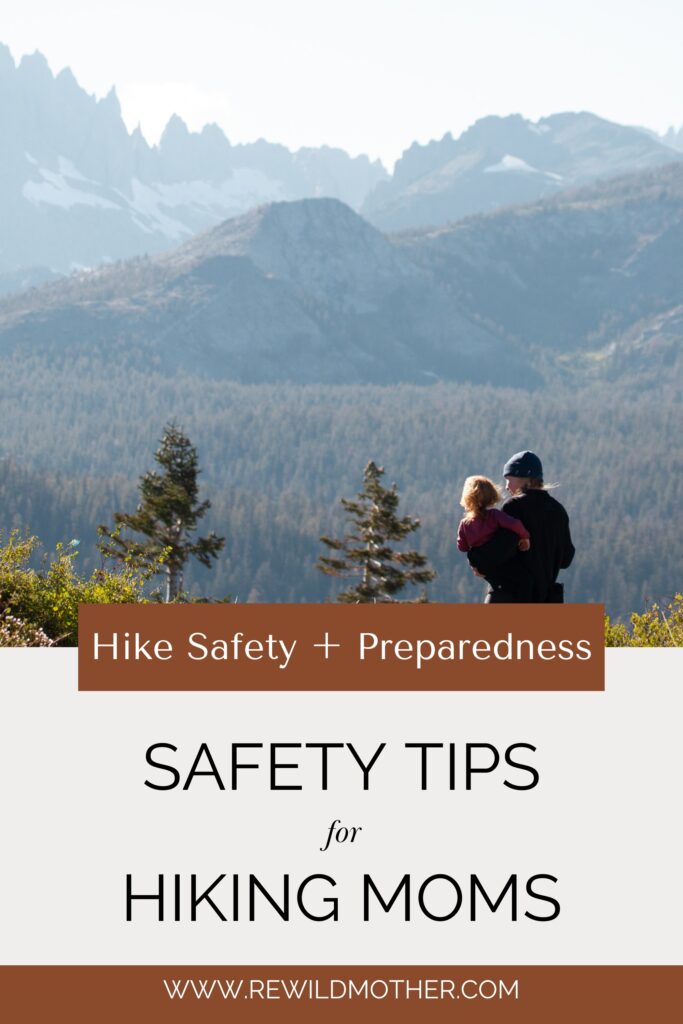
Soon, I will be publishing a post about what items to keep in a kids hiking backpack with links to the products I love and personally use. Make sure to subscribe below so I can let you know when that info is up on this blog!
While I realize that the idea of meeting a mountain lion on the trail with your kids in tow is a pretty horrifying thought, I hope this post provided helpful tips and confidence that you CAN keep yourself and your kids safe. I truly believe that the biggest piece of the puzzle of safety in the wilderness is being mentally prepared. Since you made it through this entire post, I feel confident in saying that you are ready to be the greatest Mama Bear in the wilderness! Knowledge is power!
Please feel free to share this blog post or save it to Pinterest so others can learn from it, too. I’m always so grateful to everyone who shares and supports my work!
Until next time,
Go hit the trails and have fun out there!
xx,
Kaleigh
Sources:
https://www.nps.gov/articles/mountain-lion-safety.htm
https://www.nps.gov/samo/learn/nature/pumapage.htm
https://www.advnture.com/features/what-to-do-if-you-meet-a-mountain-lion
https://mountainlion. org/
For the mountain lion in the tree story, go to @malibuvop or @thelocalmalibu on Instagram
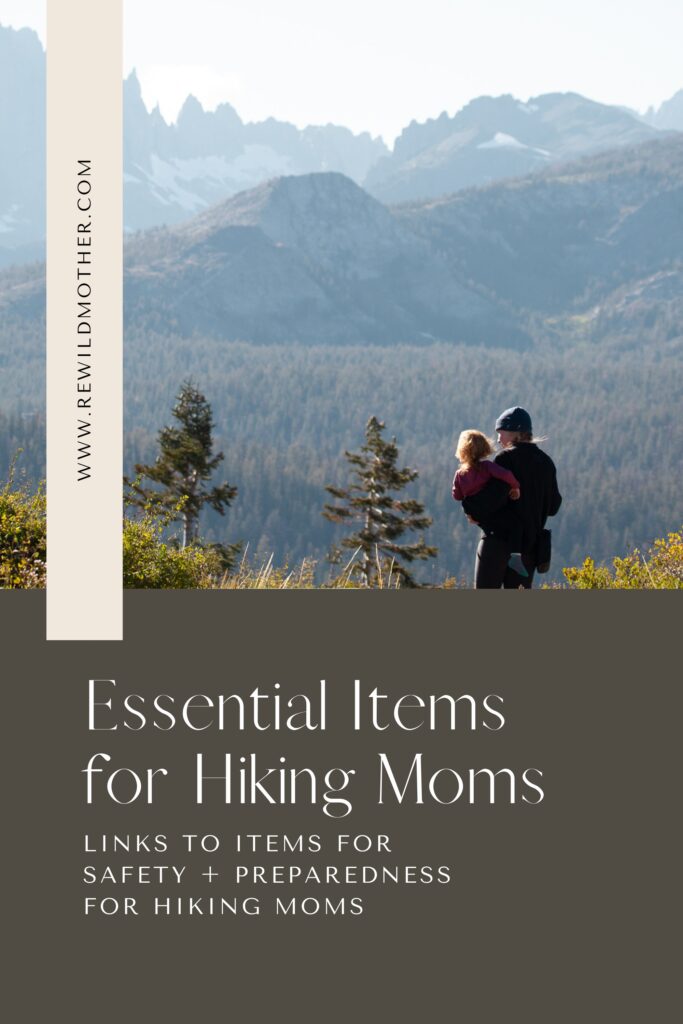
View comments
+ Leave a comment